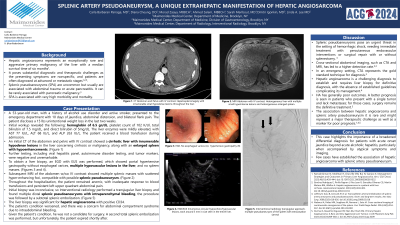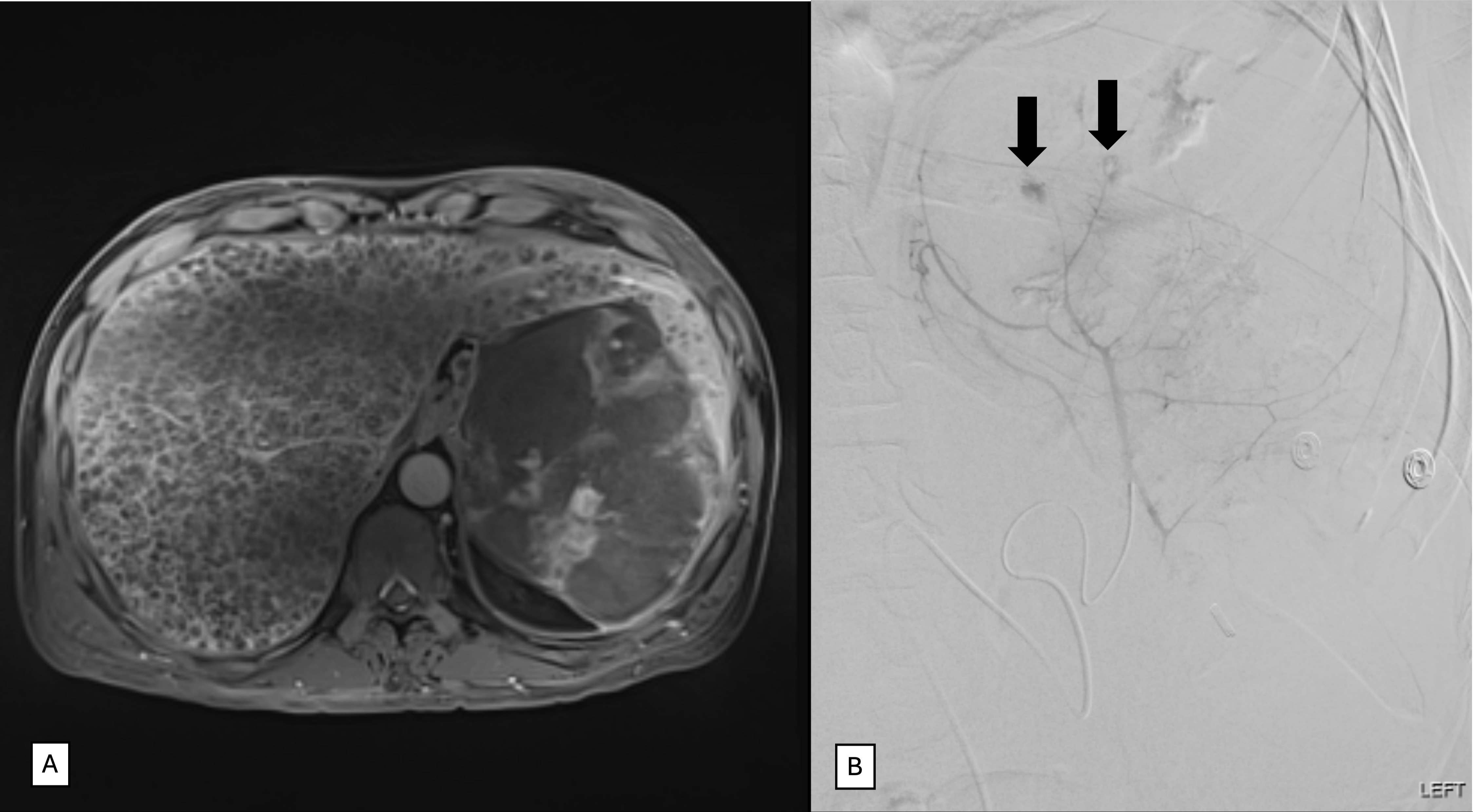Monday Poster Session
Category: Liver
P3083 - Splenic Artery Pseudoaneurysm: A Unique Extrahepatic Manifestation of Hepatic Angiosarcoma
Monday, October 28, 2024
10:30 AM - 4:00 PM ET
Location: Exhibit Hall E

Has Audio

Carla Barberan Parraga, MD
Maimonides Medical Center
New York, NY
Presenting Author(s)
Carla Barberan Parraga, MD1, Diana Cheung, DO2, Morad Zaaya, MBCh2, Ahmed Salem, MBBCh2, Sarah Meribout, MD2, Dmitri Igonkin, MD2, Linda A. Lee, MD, MBA3
1Maimonides Medical Center, New York, NY; 2Maimonides Medical Center, Brooklyn, NY; 3North Shore University Hospital - Northwell Health, New Hyde Park, NY
Introduction: Hepatic angiosarcoma represents an exceptionally rare and aggressive primary malignancy of the liver with a median survival time of six months. It poses substantial diagnostic and therapeutic challenges as the presenting symptoms are nonspecific, and patients are often diagnosed at advanced or metastatic stages.
Case Description/Methods: We describe a case of a 53-year-old man with a history of alcohol use who presented to the emergency department with ten days of jaundice, abdominal distension, and bilateral flank pain associated with unintentional 10 lbs weight loss. He described daily alcohol use of 4-5 beers. Initial workup revealed anemia with a hemoglobin of 6.5 gr/dL, platelet count of 102 K/UL, total bilirubin of 7.5 mg/dL, direct bilirubin of 5 mg/dL, AST 77 IU/L; ALT 68 IU/L, ALP 263 IU/L. Serologic testing for viral hepatitis, autoimmune disorders, and tumor markers were negative. EGD with EUS showed portal hypertensive gastropathy without esophageal varices and multiple hypoechoic hypovascular lesions in the liver. MRI abdomen w/wo IV contrast showed multiple splenic masses with scattered hyper-enhancing foci, indicating possible splenic pseudoaneurysms. The patient remained anemic with inadequate response to blood transfusions and with persistent left upper quadrant abdominal pain. Interventional radiology performed a transjugular liver biopsy and found multiple distal splenic pseudoaneurysms with intraparenchymal bleeding noted. The patient underwent subtotal splenic embolization. The liver biopsy revealed hepatic angiosarcoma with positive CD34. The patient’s clinical condition continued to worsen, and there was concern for abdominal compartment syndrome due to intraabdominal bleeding. A second total splenic embolization was performed, but unfortunately, the patient expired shortly after.
Discussion: This case highlights the importance of a broad differential diagnosis for patients with acute onset jaundice beyond acute alcoholic hepatitis, particularly when accompanied by atypical symptoms and imaging. Hepatic angiosarcoma is a challenging diagnosis to establish and requires liver biopsy for definitive diagnosis. Splenic pseudoaneurysms are usually associated with abdominal trauma and acute pancreatitis. In the setting of hemorrhagic shock, early recognition and emergent intervention with endovascular treatment or surgical repair with or without splenectomy can improve patient outcomes.

Disclosures:
Carla Barberan Parraga, MD1, Diana Cheung, DO2, Morad Zaaya, MBCh2, Ahmed Salem, MBBCh2, Sarah Meribout, MD2, Dmitri Igonkin, MD2, Linda A. Lee, MD, MBA3. P3083 - Splenic Artery Pseudoaneurysm: A Unique Extrahepatic Manifestation of Hepatic Angiosarcoma, ACG 2024 Annual Scientific Meeting Abstracts. Philadelphia, PA: American College of Gastroenterology.
1Maimonides Medical Center, New York, NY; 2Maimonides Medical Center, Brooklyn, NY; 3North Shore University Hospital - Northwell Health, New Hyde Park, NY
Introduction: Hepatic angiosarcoma represents an exceptionally rare and aggressive primary malignancy of the liver with a median survival time of six months. It poses substantial diagnostic and therapeutic challenges as the presenting symptoms are nonspecific, and patients are often diagnosed at advanced or metastatic stages.
Case Description/Methods: We describe a case of a 53-year-old man with a history of alcohol use who presented to the emergency department with ten days of jaundice, abdominal distension, and bilateral flank pain associated with unintentional 10 lbs weight loss. He described daily alcohol use of 4-5 beers. Initial workup revealed anemia with a hemoglobin of 6.5 gr/dL, platelet count of 102 K/UL, total bilirubin of 7.5 mg/dL, direct bilirubin of 5 mg/dL, AST 77 IU/L; ALT 68 IU/L, ALP 263 IU/L. Serologic testing for viral hepatitis, autoimmune disorders, and tumor markers were negative. EGD with EUS showed portal hypertensive gastropathy without esophageal varices and multiple hypoechoic hypovascular lesions in the liver. MRI abdomen w/wo IV contrast showed multiple splenic masses with scattered hyper-enhancing foci, indicating possible splenic pseudoaneurysms. The patient remained anemic with inadequate response to blood transfusions and with persistent left upper quadrant abdominal pain. Interventional radiology performed a transjugular liver biopsy and found multiple distal splenic pseudoaneurysms with intraparenchymal bleeding noted. The patient underwent subtotal splenic embolization. The liver biopsy revealed hepatic angiosarcoma with positive CD34. The patient’s clinical condition continued to worsen, and there was concern for abdominal compartment syndrome due to intraabdominal bleeding. A second total splenic embolization was performed, but unfortunately, the patient expired shortly after.
Discussion: This case highlights the importance of a broad differential diagnosis for patients with acute onset jaundice beyond acute alcoholic hepatitis, particularly when accompanied by atypical symptoms and imaging. Hepatic angiosarcoma is a challenging diagnosis to establish and requires liver biopsy for definitive diagnosis. Splenic pseudoaneurysms are usually associated with abdominal trauma and acute pancreatitis. In the setting of hemorrhagic shock, early recognition and emergent intervention with endovascular treatment or surgical repair with or without splenectomy can improve patient outcomes.

Figure: A. MRI Abdomen with IV contrast. Heterogeneous liver with multiple small hyperintense lesions and heterogeneous enlarged spleen. B. Interventional radiology transjugular approach, multiple pseudoaneurysms of the spleen with extravasation (arrow).
Disclosures:
Carla Barberan Parraga indicated no relevant financial relationships.
Diana Cheung indicated no relevant financial relationships.
Morad Zaaya indicated no relevant financial relationships.
Ahmed Salem indicated no relevant financial relationships.
Sarah Meribout indicated no relevant financial relationships.
Dmitri Igonkin indicated no relevant financial relationships.
Linda Lee indicated no relevant financial relationships.
Carla Barberan Parraga, MD1, Diana Cheung, DO2, Morad Zaaya, MBCh2, Ahmed Salem, MBBCh2, Sarah Meribout, MD2, Dmitri Igonkin, MD2, Linda A. Lee, MD, MBA3. P3083 - Splenic Artery Pseudoaneurysm: A Unique Extrahepatic Manifestation of Hepatic Angiosarcoma, ACG 2024 Annual Scientific Meeting Abstracts. Philadelphia, PA: American College of Gastroenterology.

